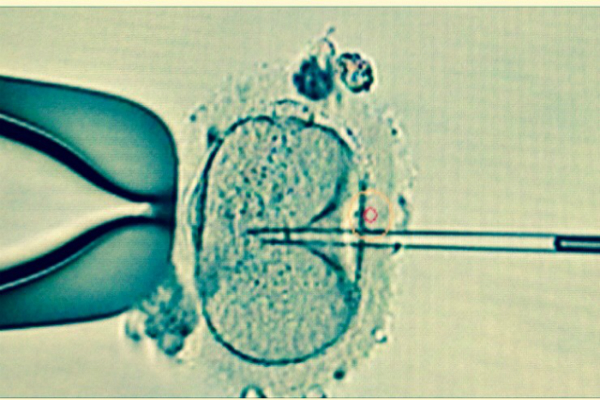
Toying Around: How This Lesbian Entrepreneur Is Changing the Sex Toy Scene for the Better
January 2, 2018
Photos: Cosmic Q Year’s Eve
January 5, 2018Whether through intentional single parenthood, a coupled relationship, or a multiple person family structure, more queer individuals and families are choosing to access fertility services than ever before.
Before embarking on the fertility journey, there are some important factors to take into account regarding readiness for parenthood. Organizations such as Rainbow Families in the Washington, DC area offer classes specifically addressing this and discuss the various options that queer parents have including carrying a pregnancy, using a gestational carrier and adoption.
Considerations that may be brought up during this preparation process include whose genetic material (eggs/sperm, anonymous vs. known) will be involved and who will carry the pregnancy. Other aspects such as financial limitations, social support, family/genetic history, fears/expectations of parenting and stress management strategies may also play a role in if or when an individual decides to pursue parenthood.
Conception can also involve many different types of bodies and genders, depending on a person’s reproductive planning goals. Fertility and pregnancy related services may be heavily gendered or heteronormative, often with presumptive language that does not apply to queer families. Because of this, it’s important to find a provider who understands your unique needs.
As background, the term “fertility” refers to one’s ability to become pregnant. “Infertility” refers to one’s inability to get pregnant after 12 months of trying to conceive, at which point it is recommended to seek an evaluation. (If a person is above the age of 35, the recommendation is to begin a fertility evaluation after six months of trying to conceive, as time may play a more important role.)
However, note that this medical definition of infertility refers to cisgender, heterosexual individuals having intercourse at home. Many queer individuals will not fit the definition of infertility due to not having access to both eggs and sperm. Folks also may not have prior knowledge of reproductive disorders that may be found in an initial fertility evaluation and workup.
Factors that may influence fertility include:
- Menstrual and ovulation patterns
- Age, past medical history
- Hormonal medications
- Disorders such as PCOS and endometriosis
- Thyroid issues
Fertility Testing
The fertility evaluation process first begins with a detailed review of family and medical histories, a physical exam with lab screenings and an assessment of lifestyle habits. This may be done for one person, or more than one, depending on whose biological material will be involved. After the initial consultation and results, further diagnostic testing may be warranted to evaluate a person’s fertility potential and gather data.
Determining what amount of testing to perform can be a little bit tricky, as it’s important not to over medicalize or pathologize queer conception. Different individuals may prefer to have all of the information available prior to conception and others may prefer minimal testing. These tests may include bloodwork, sonograms, genetic testing, semen analysis, and a procedure to determine if the fallopian tubes are open or blocked.
Bloodwork and sonograms may need to be repeated several times within the same month, as hormone levels fluctuate significantly throughout a person’s cycle. Through fertility testing, sometimes endocrine or reproductive disorders, such as PCOS, thyroid disease or endometriosis may be discovered which can impact one’s ability to conceive.
It is generally believed that those with ovaries will be born with all of the eggs they will ever have in their lifetime. Data shows that at age 30, a person with ovaries has an average of 120,000 eggs and that by age 37, the number declines to an average of 25,000. However, this decline can be either steep or gradual and does not necessarily correlate with one’s general health or family fertility history. While we do have tests that reflect the quantity of eggs, no current testing exists that can relay the quality of a person’s eggs, which is often a question in the process.
Learning about what your body’s fertility potential is now can be a great starting point for figuring out your long term timeline and goals. You certainly do not need to be ready to conceive immediately in order to schedule an appointment, many individuals come in 6 months to several years prior to conception. Some individuals also obtain early consults to be able to consider the use of fertility cryopreservation-that is, freezing eggs or sperm-in achieving their long term reproductive goals, which can help a person delay parenthood until a more optimal time in their life, while still maintaining the age of the genetic material at the time it is frozen.
Intrauterine Insemination (IUI)
Intrauterine insemination is an effective conception technique used most commonly for individuals or couples using donor sperm and/or those who choose a surrogate, but may also be used in other scenarios as well. It utilizes a process by which washed sperm (donor or partner’s) are placed through the cervix and released inside the uterus. This insemination technique is used to place the most optimal sperm as close to the fallopian tubes as possible, which is where fertilization takes place.
This process can be beneficial because it bypasses several physical barriers and increases the chances of conception. It is not recommended for patients with blocked or absent fallopian tubes or severe sperm factor infertility. While it can be tough to determine appropriate expectations for whether or not IUI will work for a person, it is very normal for it to take three to six cycles to be successful.
In Vitro Fertilization (IVF)
IVF refers to a process in which fertilization of an egg takes place outside the body, creating an embryo, which is then transferred back to the body. The recipient may be the intended parent, a surrogate or a gestational carrier, depending on the situation. Most often, we use IVF after a series of unsuccessful IUI cycles but it may also be used in a variety of other scenarios. One such scenario is in the case of reciprocal IVF, which utilizes one partner’s eggs to create an embryo which is then placed in a second partner’s uterus to carry the pregnancy. While IVF in general is more involved, costly and certainly not appropriate for everyone, the success rate per cycle is significantly higher. Learning more about the costs of IVF in comparison to other fertility treatments is highly recommended before embarking on such a costly journey.
Surrogacy and Gestational Carriers
A surrogate is an individual who donates their own egg(s) and uterus in order to help an individual/couple have a baby. In most cases, the egg is fertilized by sperm from one of the partners, but may also utilize donor sperm. Gestational carriers are like surrogates in the sense that they donate the use of their uterus and body to carry the pregnancy and give birth. The difference is that the person does not donate/use their own egg(s). Rather, an embryo is created using a donor egg and donor sperm and then transferred into the uterus via the IVF process.
The idea is that the intended parent(s) and the gestational carrier will remain in close contact during the conception process and pregnancy so the intended parent(s) are included as much as possible in the development of their baby, as well as the birth. The intended parents will then be the child’s legal parent(s)/guardian(s). Many states differ by law in terms of what this process requires and whether or not surrogacy is considered legal.
So what do I do now?
Because ovulatory disorders account for about 15% of infertility cases, one of the most helpful things a person can do is track the length and frequency of their menstrual cycle using a calendar or app prior to coming in for a fertility evaluation. This can help the clinician determine whether ovulation is occurring and what the next best step may be. Learning about how the menstrual cycle works, what the signs of ovulation are and the process through which pregnancy occurs is often the most helpful foundation for folks wanting to get started.
Framing fertility testing and treatment as a process can be helpful and many people find having a compassionate counselor or therapist, even in the very beginning, can help make the experience less stressful on both you and/or your relationship(s).
Below are several resources for prospective parents to learn about more of their options. If you still have further questions, it’s often a good idea to book an appointment with a fertility specialist who can discuss your individual goals more in depth with you.
Signey Olson is a DC-based nurse practitioner and nurse-midwife whose work focuses on providing inclusive care to her queer community. She works primarily in GYN, fertility, and trans-affirming care at Columbia Fertility Associates.
Want to know more about queer fertility? Read Queer Fertility Part Two and find out what people wish they knew.





